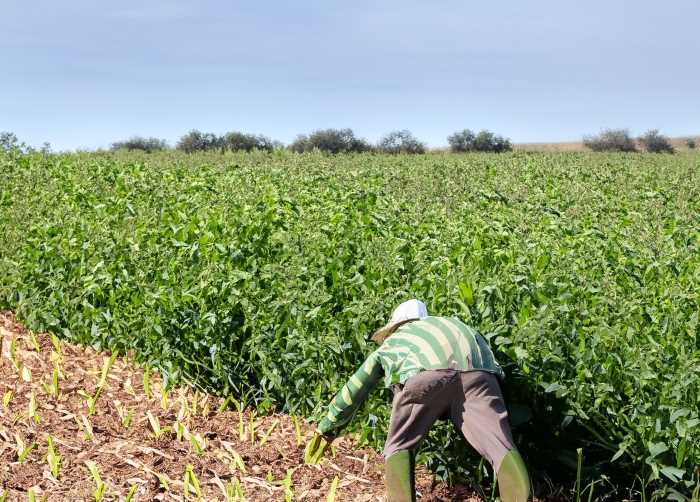How Barbecho Turns Idle Fields into Productivity Powerhouses
Discover the benefits of barbecho in agriculture. Restoring soil nutrients, managing pests naturally, conserving moisture, and promoting biodiversity. Learn how this traditional practice enhances sustainability.

In the world of agriculture, there are numerous practices that farmers employ to maximize crop productivity and promote sustainable land management. One such practice is barbecho, a traditional agricultural technique that involves leaving tilled land unsown for one or more years before planting crops.
Barbecho, also known as fallow or fallow field, offers a range of benefits that contribute to the overall health of the soil and the long-term sustainability of agricultural systems. In this article, we will explore the advantages of barbecho and its significance in modern farming practices.
Understanding Barbecho
Barbecho is derived from the Spanish term "barbechar," which means to plow and prepare the land for cultivation. It involves leaving the land fallow or unplanted for a certain period, allowing it to rest and regenerate its natural fertility. During this fallow period, the soil undergoes a series of beneficial processes, which ultimately enhance its health and productivity.
Restoring Soil Nutrients and Structure
One of the primary benefits of barbecho is its ability to restore soil nutrients and improve its structure. Continuous cropping depletes the soil of essential nutrients, resulting in decreased fertility over time. By allowing the land to lay fallow, the natural processes of nutrient cycling and organic matter decomposition occur unhindered. As a result, the soil regains its nutrient content, providing a rich foundation for future crop growth. Additionally, the absence of active tillage during barbecho helps preserve soil structure, preventing erosion and enhancing water infiltration.
Weed and Pest Management
Barbecho acts as a natural weed and pest management tool. Fallowing the land interrupts the life cycles of many common weeds and pests, reducing their populations without the need for synthetic herbicides or pesticides. The lack of host crops disrupts the reproduction and survival of weed seeds, significantly reducing weed pressure in subsequent growing seasons. Additionally, fallowing breaks the lifecycle of certain soil-borne pests, helping to control their numbers naturally.
Soil Moisture Conservation
Water scarcity is a significant concern in many agricultural regions. Barbecho can play a crucial role in conserving soil moisture. Leaving the land fallow reduces evapotranspiration, allowing the soil to retain more moisture. This additional water availability benefits subsequent crops during their growth stages, especially in areas prone to drought or with limited irrigation resources. Improved moisture conservation can lead to higher crop yields and more efficient use of water.
Biodiversity and Habitat Restoration
Barbecho supports biodiversity conservation and habitat restoration on farmlands. The fallow period allows the re-establishment of native vegetation, providing food and shelter for various organisms. This, in turn, enhances ecological balance and promotes the presence of beneficial insects, pollinators, and soil microorganisms. Biodiversity restoration contributes to the overall resilience of agricultural systems and helps mitigate the impact of pests and diseases.
Modern Applications of Barbecho
While barbecho has its roots in traditional agricultural practices, it has found renewed relevance in modern farming systems. Farmers and researchers have adapted the concept of barbecho to suit different contexts and specific agricultural goals. Some notable adaptations include:
- Cover Cropping: Instead of leaving the land completely fallow, farmers plant cover crops during the fallow period. These cover crops, such as legumes or grasses, provide soil cover, prevent erosion, fix atmospheric nitrogen, and add organic matter to the soil when they are eventually incorporated.
- Rotational Fallowing: In areas where continuous cropping is challenging due to specific climatic conditions or pests, farmers adopt rotational fallowing. They alternate between planting crops and leaving the land fallow, giving the soil time to recover and reducing the build-up of pests or diseases associated with continuous cropping.
- Conservation Tillage: Another adaptation of barbecho is conservation tillage, which involves reducing or eliminating tillage operations to minimize soil disturbance. This technique helps maintain soil structure, preserve soil moisture, and promote the accumulation of organic matter, mirroring some of the benefits of traditional barbecho.

Best Practices for Implementing Barbecho
When incorporating barbecho into farming practices, several key factors should be considered:
- Planning and Timing: Careful planning is essential to ensure that the fallow period aligns with the specific cropping system and regional climate. Understanding the natural regeneration processes and nutrient cycling dynamics of the soil can help determine the optimal duration of the fallow period.
- Weed Control: While barbecho helps reduce weed pressure, it is important to manage weeds effectively during the fallow period to prevent them from setting seed and becoming a future problem. Mechanical methods, such as mowing or hand weeding, can be employed to keep weed populations in check.
- Soil Protection: To prevent soil erosion during the fallow period, implementing erosion control measures such as cover cropping, contour plowing, or the use of mulch is crucial. These practices safeguard the soil from the impact of heavy rainfall or wind erosion.
- Integrated Pest Management (IPM): Barbecho can contribute to integrated pest management strategies by disrupting pest life cycles. However, it is important to monitor pest populations and take appropriate action if necessary. Incorporating diverse plant species and implementing cultural practices that promote natural pest control can enhance the effectiveness of barbecho as an IPM tool.
Barbecho in Sustainable Agriculture
As the need for sustainable agriculture intensifies, practices like barbecho are gaining recognition for their potential to improve soil health, reduce chemical inputs, and enhance overall farm resilience. Barbecho offers a myriad of benefits, from soil restoration and moisture conservation to weed and pest management. Its adaptability to various agricultural systems and its compatibility with modern conservation practices make it an attractive option for farmers worldwide.
Further research and experimentation are ongoing to refine barbecho techniques, optimize its integration with other sustainable practices, and explore its potential in mitigating climate change impacts. With its ability to promote long-term soil fertility, biodiversity conservation, and water resource management, barbecho holds promise as an essential component of sustainable agriculture in the years to come.
In conclusion, barbecho, the practice of leaving tilled land fallow for some time, offers numerous benefits to soil health and sustainable agriculture. Its ability to restore soil nutrients, manage weeds and pests naturally, conserve soil moisture, and support biodiversity makes it a valuable tool for modern farmers.
By adapting and incorporating barbecho into farming systems using best practices and considering local conditions, farmers can reap the rewards of improved soil fertility and long-term sustainability. As the world faces increasing challenges in food production and environmental stewardship, barbecho stands as a promising solution for a resilient and sustainable agricultural future.




